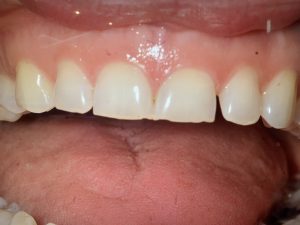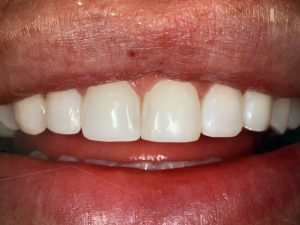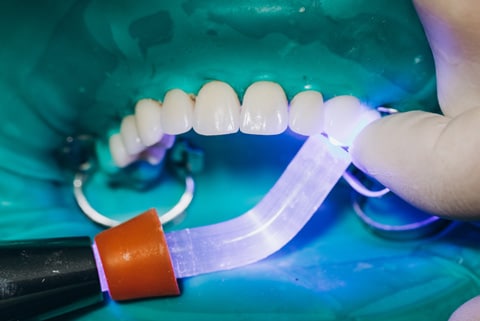Contents
1. Introduction to Composite Bonding for Front Teeth
2. Procedure
2.1 Composite bonding for two front teeth
2.2 Composite bonding for four front teeth
2.3 Composite bonding for six front teeth
3. Composite Bonding Before and After
4. Benefits
5. Aftercare
6. Does Bonding Work on Front Teeth?
7. How Strong is Composite on Front Teeth?
8. How Long Does Composite Bonding Last on Front Teeth?
9. How Many Times Can Front Teeth Be Bonded?
11. Conclusion and Next Step
Introduction to Composite Bonding for Front Teeth
Composite bonding is a cosmetic and restorative dental treatment that transforms damaged teeth by carefully building up layers of composite resin over the tooth’s natural surface. Chips, cracks, gaps, and misshaped, discoloured, and crooked teeth can all be restored using the composite bonding technique.
This procedure is considered safe and a cost-effective solution to treat a range of dental issues. Composite bonding can be applied to just one tooth, or a number of teeth if required, and can build up lost tooth structure of the front and back teeth.
A relatively modern technique, composite bonding treatment is often used as an alternative to braces, to fix chipped, broken, or discoloured teeth, to create a confident smile, and to treat gum recession. However, it is important to remember that composite bonding is not a permanent treatment and will need maintenance at some point in the future.
Procedure
In most cases, composite bonding only requires one visit to the dentist and can transform your smile just sitting, making it a fast and effective cosmetic procedure. The treatment is pain-free and pocket-friendly with long-lasting, natural-looking results.
After an initial consultation with your dentist to ensure composite bonding is right for you, at your appointment your dentist will select a shade of resin material that matches your natural tooth appearance. A great match ensures a natural-looking smile.
Then your dentist will prepare your tooth or teeth. The tooth surface will be roughened to help the resin material bond and stick. Once prepped, the composite resin, which has a putty-like consistency, will be applied to your tooth, and moulded to the desired shape.
To cure the resin, your dentist will use a special curing light that bonds the resin to the surface. This light will completely cure and harden the composite resin allowing you to make ‘hard bites’ just minutes after the appointment.
Finally, any adjustments will be made, and your dentist will polish your tooth to create a natural-looking shine. On average, the treatment takes between 30 minutes and one hour per tooth. The more teeth you have treated, the longer the procedure will take.
-
Composite bonding for two front teeth
Many people choose composite bonding to close the gap between two front teeth or as an alternative to braces and porcelain veneers. If you are unhappy with your two front teeth, dental bonding is a great way to restore tooth appearance and boost your confidence.
On average, composite bonding can last between four and eight years depending on the bonding location and your lifestyle habits and choices. Your two front teeth are exposed every day, whether that be while speaking or eating, so for this reason, composite bonding on two front teeth requires increased maintenance.
-
Composite bonding for four front teeth
Composite bonding can also be used to restore multiple teeth at once. Whether it is to restore discoloured, damaged, and misshapen teeth, close multiple gaps between teeth, or just an extra measure to perfect your smile, composite bonding is a cost-effective alternative to traditional dental methods such as porcelain veneers.
With composite bonding, you can enhance the appearance of your four front teeth fast.
-
Composite bonding for six front teeth
In just one appointment, your dentist can transform your six front teeth with composite bonding with fast and effective results. With a thin layer of composite resin applied to each tooth, a skilful dentist can improve your natural tooth shape, correct cracks, fill in gaps, and hide the appearance of misaligned teeth.
Composite Bonding Before and After


Benefits
There are many benefits when you choose composite bonding. Here are a few benefits patients can expect from composite bonding:
✓ Long-lasting results
✓ A pain-free procedure
✓ No recovery period is required
✓ Affordable and cost-effective
✓ A safe treatment
✓ A healthier more confident smile
✓ Fast results
Aftercare
Due to the non-invasive nature of composite bonding treatment, there is no recovery time. Immediately after treatment, you will be able to proceed with your regular day-to-day life. However, for the best results and to maximise the life of your composite bonding, you should follow some simple aftercare steps.
For at least 48 hours after the procedure, you should avoid smoking, tea, and coffee to reduce the risk of staining. You should also resist biting your nails or grinding your teeth as this can chip the resin material and your natural tooth.
Long-term aftercare tips include brushing your teeth regularly after eating and drinking, maintaining good oral health, and visiting your dentist at least once every six months for a check-up. You should never use your teeth as tools, bite directly into hard food, or use mouthwash as a replacement for brushing.
To prolong the lifespan of tooth bonding you should always follow the aftercare steps mentioned by your dentist at the time of the appointment.
Does Bonding Work on Front Teeth?
Dental bonding can be applied to all teeth including your front teeth. However, as your front teeth are exposed during every activity such as chewing, drinking, and talking, they are likely to require more regular maintenance than composite bonding to back and side teeth.
With the right care and attention, composite bonding on front teeth can last between four to eight years but this is dependent on a number of additional factors too. The strength of your tooth, where the bonding is applied, the quality of bonding material, the quantity of bonding material, and your lifestyle habits will also contribute to the lifespan of tooth bonding.
How Strong is Composite on Front Teeth?
Healthy teeth create a strong bond with a resin material for long-lasting results which is also true when applied to front teeth. If your teeth are weak or unhealthy, the resin may form a weaker bond and eventually chip off or break.
However, composite bonding is not a permanent treatment and will require maintenance in the future even if you follow all aftercare steps and guidance. Over time, the resin will wear down and need to be replaced or repaired.
If you choose composite bonding, you should expect to have at least two bonding sessions throughout your lifetime to maintain healthy and perfect teeth.
How Long Does Composite Bonding Last on Front Teeth?
On average, bonding materials last between three and ten years before needing to be replaced or repaired. Bonding to front teeth may need to be repaired sooner due to daily exposure. However, there are a number of aftercare habits you can adopt to maximise the lifespan of your dental bonding.
Using a soft-bristled toothbrush and flossing at least once a day can help to prolong the life of bonding to the front teeth. Likewise, cutting out habits likely to damage the resin, such as biting your fingernails, grinding your teeth, and chewing ice, will also keep teeth protected.
To ensure your teeth remain healthy and your dental bonding provides you with long-term results, you should also attend routine check-ups and cleaning appointments with your dentist.
How Many Times Can Front Teeth Be Bonded?
Most people only require one initial bonding session for desired results; however, composite bonding does not last forever. For as long as you have an existing tooth structure that is strong enough to support bonding, you can bond your teeth as many times as required.
The more times you bond your front teeth, the weaker your teeth may become. If you do not have a strong structure, or your teeth are becoming weaker, your dentist will propose alternative dental treatments more suitable for you.
Likewise, if the composite resin has failed to bond with your teeth on more than one attempt, you can speak with your dentist to discuss alternative treatments.
Conclusion and Next Step
Overall, composite bonding is a pocket-friendly, pain-free dental treatment that can transform your front teeth with ease. Thanks to its straightforward procedure, composite bonding requires zero recovery time and will boost your confidence in just one session.
If you think composite bonding could be the treatment for you, contact your dentist to arrange a consultation. Ensure you choose a trusted practice for long-lasting and desirable results.
At your consultation, your dentist will discuss the procedure with you at length and prepare you for what you can expect during and after treatment. During this time, it is important to ask any questions and any issues you may have.
Boutique Dental 23 in Wigan offers a range of dental care services performed by a team of expert dentists. Whether you need to fix a chip or close an unwanted gap, they have the perfect solution.
To arrange a consultation or for more information about composite bonding, get in touch with the friendly team today.

